LED Energie brand LED bulb with following data stopped to work properly:
230V 50Hz 7W E27
450lm 3000K 60mA 20D
3684 Mod.5161
So lets make a tear-down
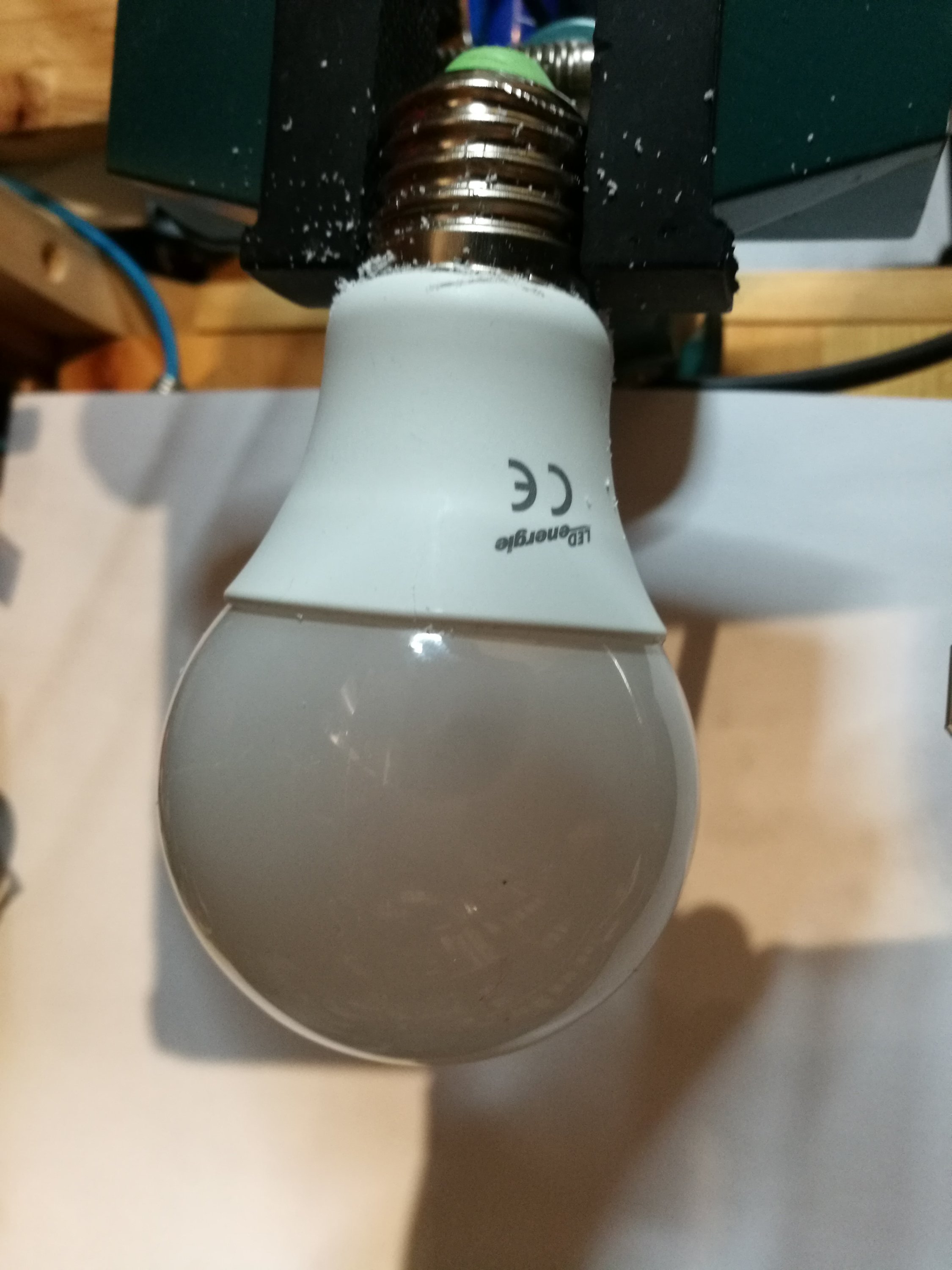
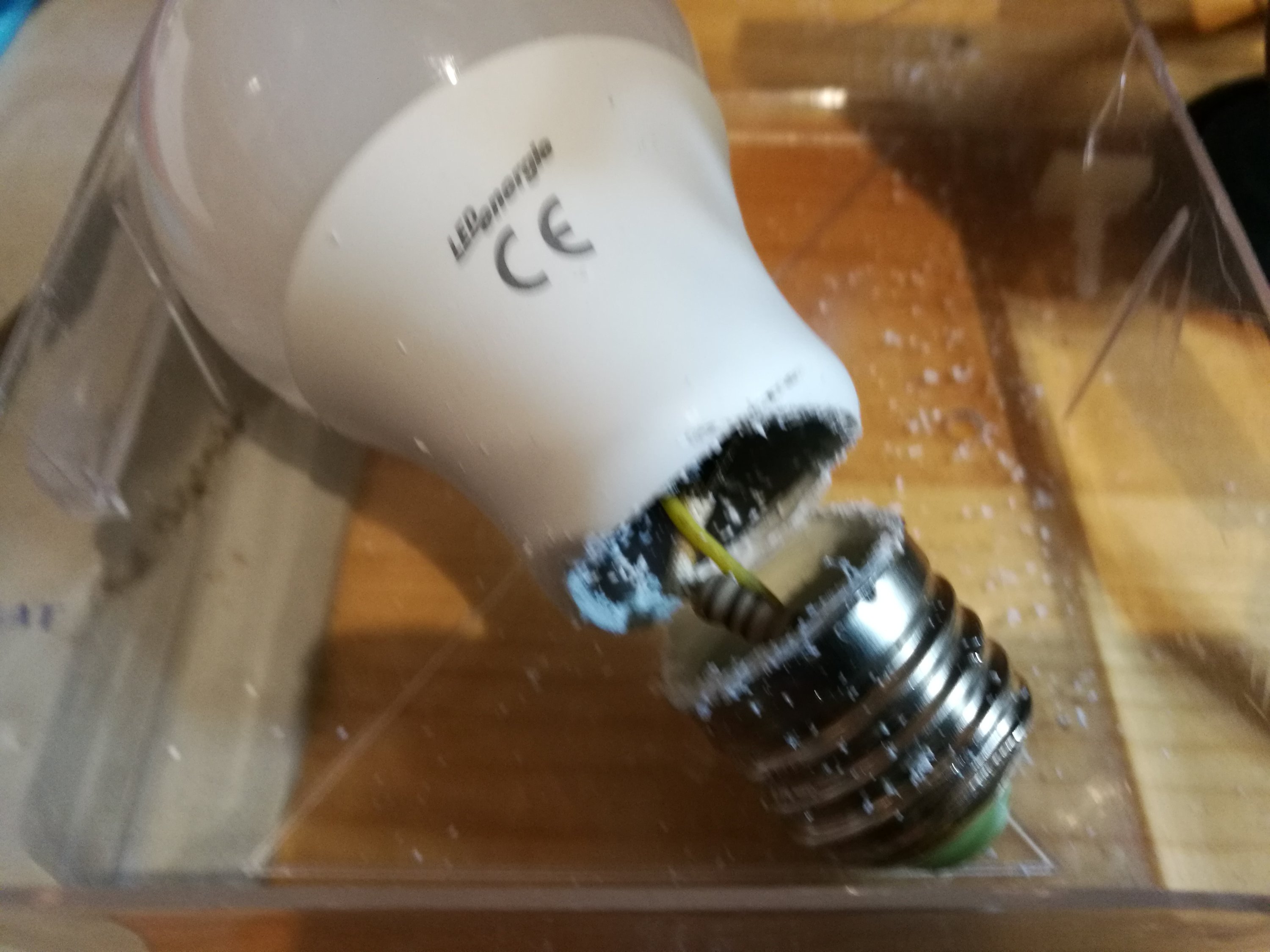
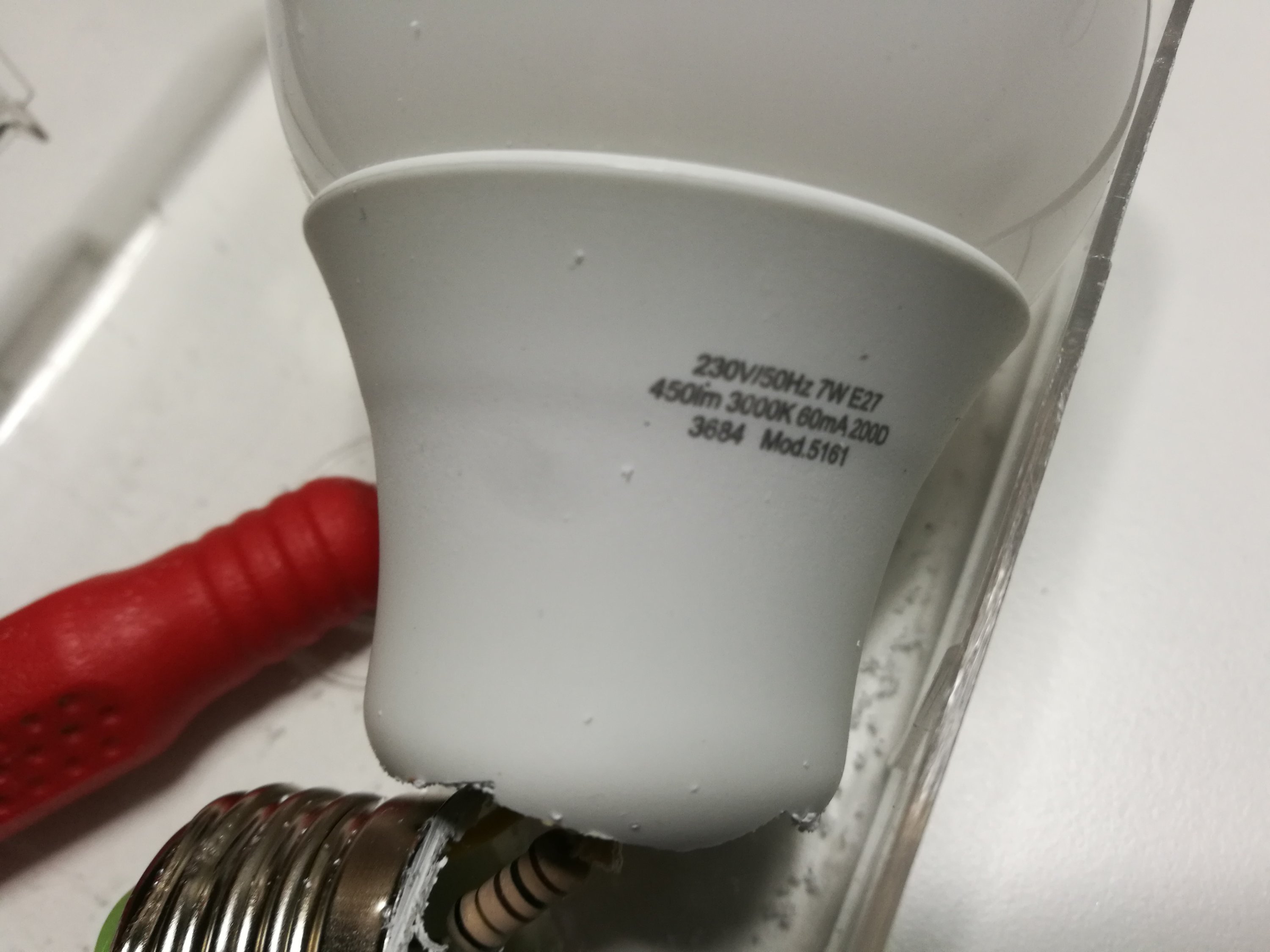
Inside
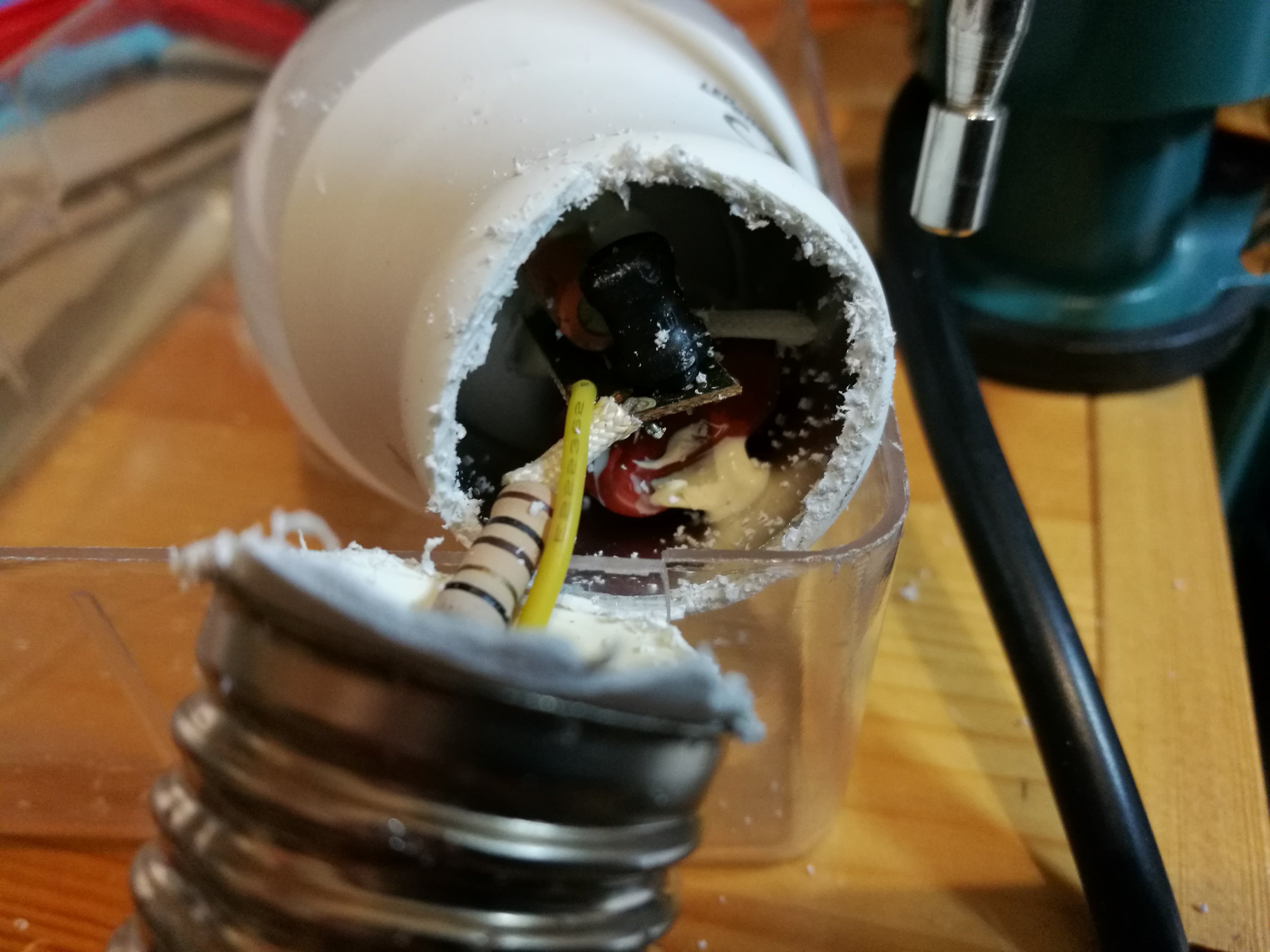
There seems to be 20 small LEDs in series inside bulb and one of them burned black. As such this LED string is expected to need around 70V over it. LEDs were soldered to a aluminium circuit board thar was glued to aluminium tube inside plastic lamp base part.
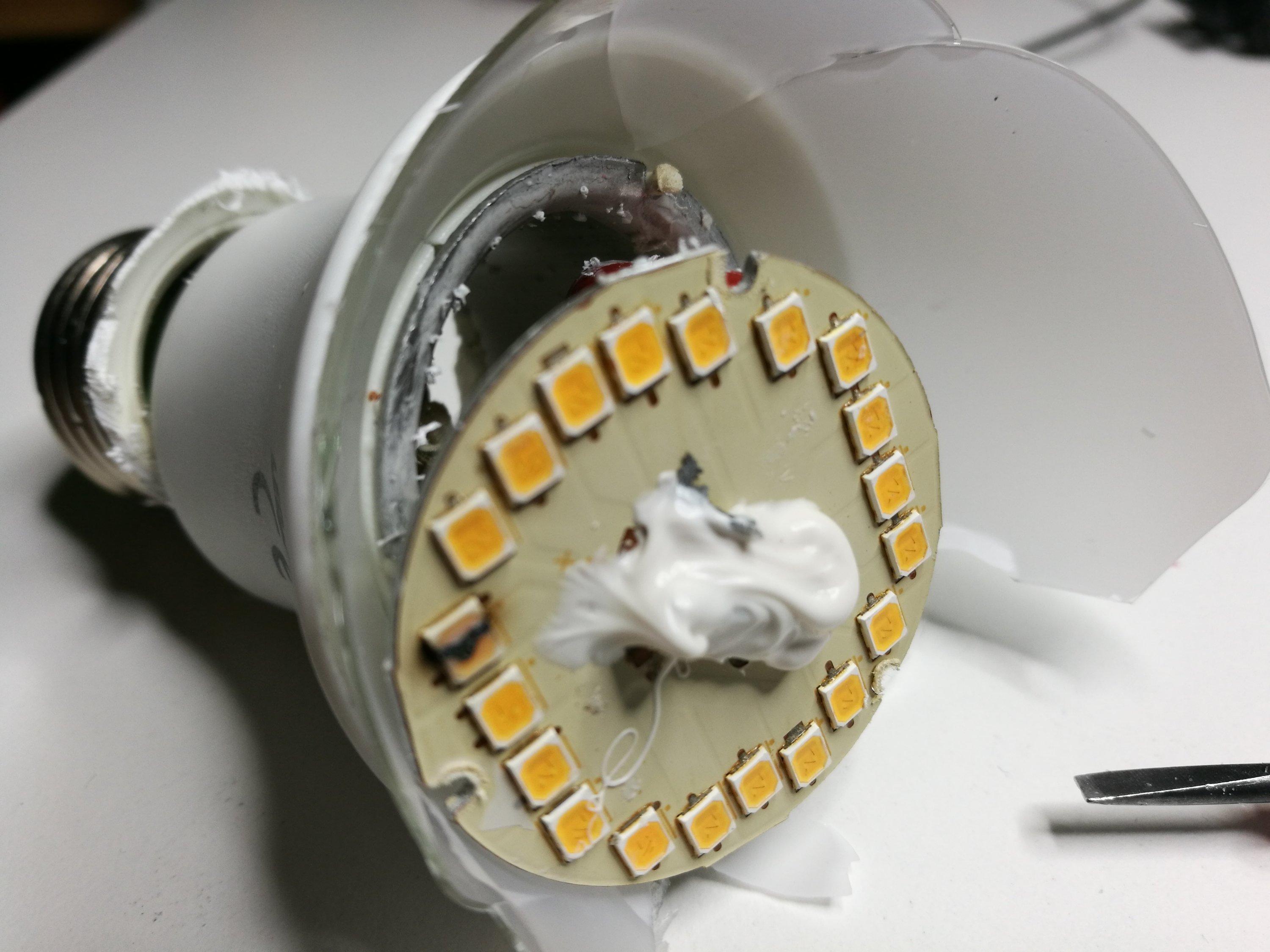
Look at the circuit board
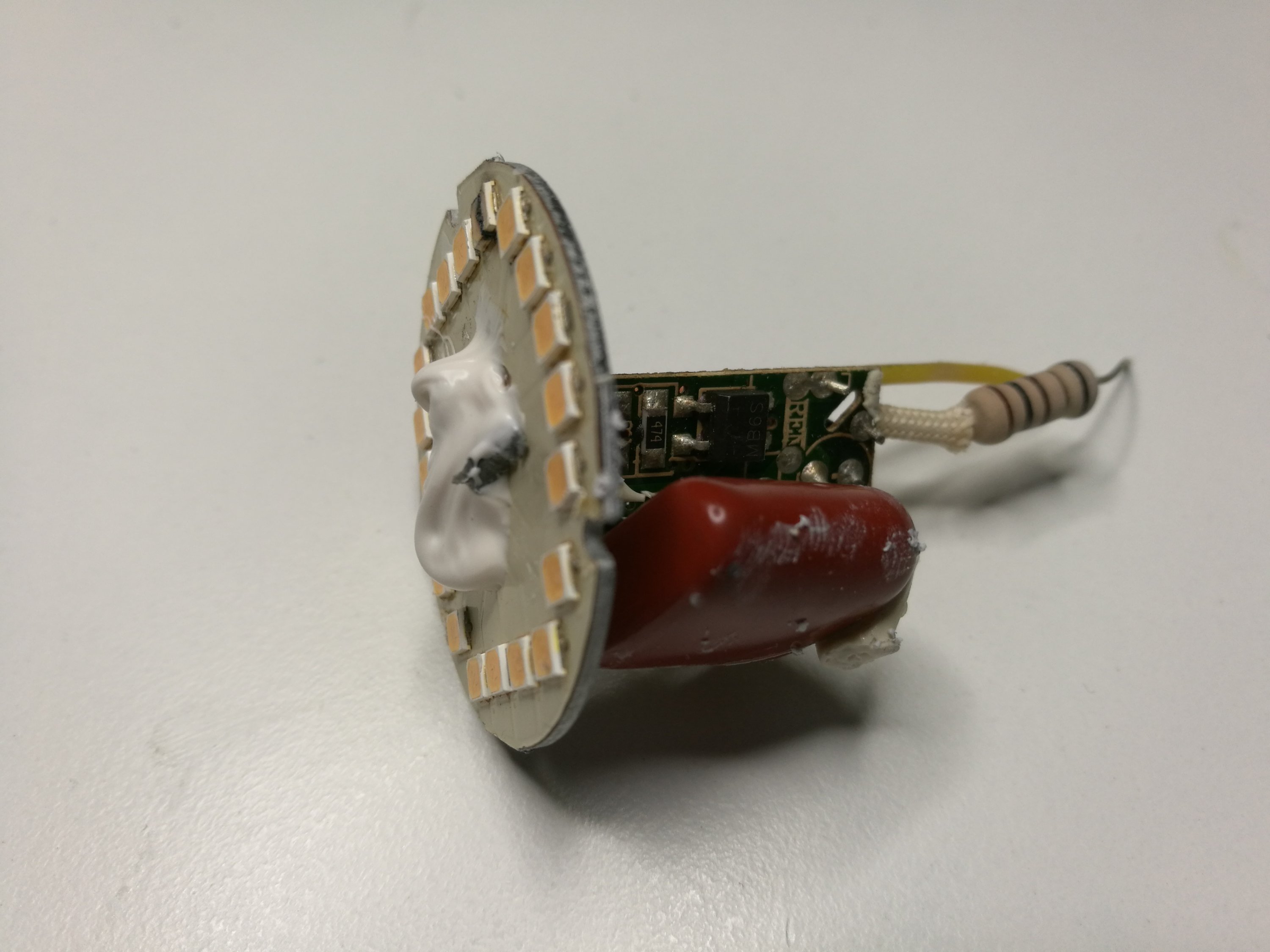
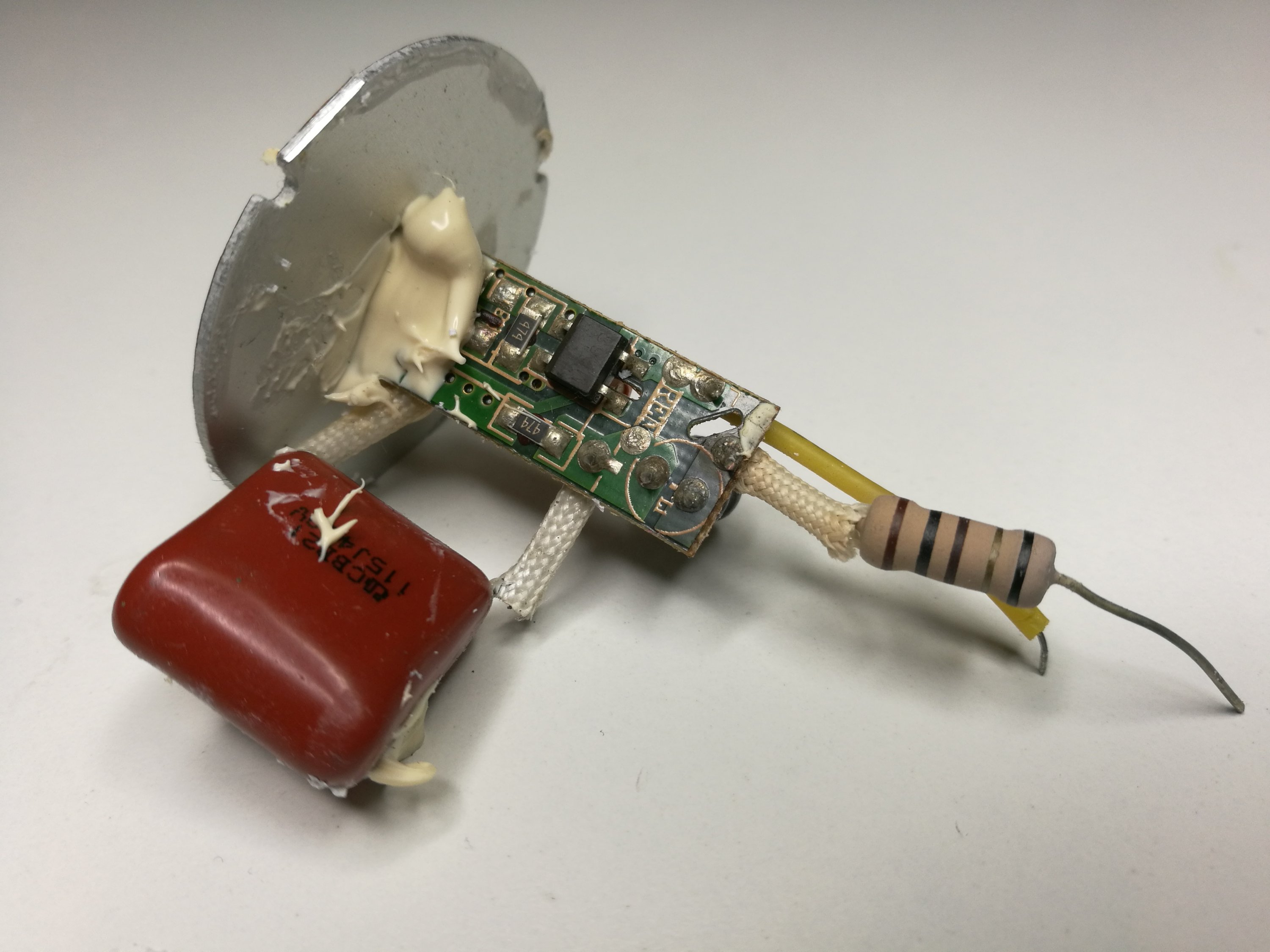
This looks like power supply is basically an RC current limiting (with small coil) followed by rectifier and small electrolytic filtering capacitor. In addition there are 470k bleder resistors to discharge capacitors.
The big resistor is a bit suspect here. According to color code it should be 100 ohms, but multimeter reading says 295 ohms. I suspect that either it has changed value or color code has changed colors due heating.
The RC circuit capacitor was 1.1uF 400V. The filter capacitor after rectifier was 2.2uF 400V electrolytic.
Here is the reverse-engineered circuit disgram:

197 Comments
Christian Real says:
Yeah Youre right the resistor value is very big that the current and voltage needed by the circuit is not supplied correctly because of that the led will become damaged
Tomi Engdahl says:
Nice analysis of one LED bulb operation and why it failed.
It seems that failing of my LED bulb has some similarities….
Old arcing switch killing LED lamps.
https://www.youtube.com/watch?v=xLhng9BI9Mw
I’ve had two Philips LED lamps of the same type fail for the same reason. Arcing switch contacts. The contacts in these switches were so black that I thought they were burnt and pitted, which would be odd for a relatively low load. It turned out that they were coated
Arcing contacts are really bad news for capacitive dropper based LED lamps as the dropper capacitors do their best to suppress the electrical noise and in doing so pass much higher current than normal. This stresses the rest of the circuitry and can kill LEDs and inrush/fusible resistors as has happened here.
This is actually a good demonstration of a typical class X capacitor or a snubber network doing its job.
Tomi Engdahl says:
Another great video, Clive!
Poundland 6W LED lamp teardown with schematic.
https://www.youtube.com/watch?v=a-exD1-6gsY
Tomi Engdahl says:
Inside a night angel illuminated socket cover. (schematic)
https://www.youtube.com/watch?v=225LhPh5uxk
Tomi Engdahl says:
Teardown of the worlds crappiest nite-lite.
https://www.youtube.com/watch?v=2Dnl6wrfmlU
While ebay has some very low quality Chinese stuff on it, this little LED night light really takes the biscuit. It’s visually unpleasant and has such hideously underrated components that it’s only fit for the bin.
Tomi Engdahl says:
Autopsy of a cremated LED lamp.
https://www.youtube.com/watch?v=TGmUTDw4g7E
i was offered some very dead LED lamps to take a look at. They sure stink of burnt stuff.
Tomi Engdahl says:
Fixing a dead LED lamp. (Interesting failure.)
https://www.youtube.com/watch?v=ol-lJ3NDY7A
Tomi Engdahl says:
Modifying Poundland LED lamps with test results.
https://www.youtube.com/watch?v=mEQ_vSYsg2I
I quite like the current range of LED globes from Poundland and thought it would be quite interesting to see what sort of effect changing the dropper capacitors to different values would have.
Tomi Engdahl says:
Teardown of a Pound World GU10 LED lamp.
https://www.youtube.com/watch?v=A2iMv6QAn28
Teardown of 5W GU10 LED lamp.
https://www.youtube.com/watch?v=3vNw9PUISRc
Tomi Engdahl says:
Mains LED lamps lighting on 12V?
https://www.youtube.com/watch?v=EbDN83B5rc4
Clint Jay left a comment on the Poundland GU10 lamp video saying that it glowed on just 12V. I tried it, and it does glow!
Then I tried it on lots of other GU10 LED lamps and just under half of them glowed, with one actually running at a full watt of power!
The ones that didn’t work probably contain a variant of the BP3102 style chip that has a built in power supply circuit that only kick-starts at a modestly high voltage, so that probably prevents them from starting on 12V. The others tend to have more discrete circuitry that is capable of running on quite low voltages.
One lamp started quite brightly on 12V but then went out, but still drew a lot of current suggesting that its circuitry had possibly locked up.
A few of the lamps actually put out useful amounts of light at 12V, so they could theoretically be used as deliberately low level lighting with a 12V battery in the event of a long term power outage.
Tomi Engdahl says:
Teardown of yet another slightly dangerous Chinese LED lamp.
https://www.youtube.com/watch?v=HsmTana3HnA
Tomi Engdahl says:
Pink plastic LED fish-o-cutor.
https://www.youtube.com/watch?v=_67yCY6k65U
I got told about this unit by someone who had bought one and it had killed the fish in their aquarium.
Tomi Engdahl says:
Weird 1W (0.1W!) LED lamp from eBay.
https://www.youtube.com/watch?v=yl7myaETgF8
It was intriguing that it had the appearance of a 4W lamp but was rated at 1W and mentioned SMD LEDs. I wanted to see how the SMD LEDs had been coupled to the lenses.
It turns out it’s not a 1W lamp and doesn’t use SMD LEDs, but it’s still quite pleasing and VERY hackable.
Tomi Engdahl says:
New, and VERY interesting Poundland 5W LED lamps.
https://www.youtube.com/watch?v=b_eU3ZpN6aE
Note that in real use the 5W lamps are showing signs of heat related failure. So it may be better sticking to the more sensibly rated 3W units.
Tomi Engdahl says:
Teardown of next-generation LED filament lamp.
https://www.youtube.com/watch?v=Nme8T2yLhL0
Tomi Engdahl says:
126 LED hydroponic death lamp.
https://www.youtube.com/watch?v=QRNYDLp4zdM
This fairly common red/blue grow lamp has a rather pleasing array of 126 LEDs arranged as 90 red with a star of 36 blue.
Hyped power is 15W. Measured power is 5.5W. Actual power dissipated in LED panel is 5W.
Lamp uses a switching buck regulator that puts out 50V at 100mA and does NOT have an isolated output.
Tomi Engdahl says:
LED filament teardown and experiments. (short version)
https://www.youtube.com/watch?v=-cFXAtX89fY
Simple resistive dropper for LED filament lamp.
https://www.youtube.com/watch?v=yGIYKLssFVI
Tomi Engdahl says:
Fascinating failure mode of metallised film capacitors.
https://www.youtube.com/watch?v=qGc9-ToEiIQ
traditional electrolytic capacitors tend to fail as their wet electrolyte dries out, and while they keep the same capacitance value their ESR (Equivalent Series Resistance) rises causing ripple and timing issues. However, I’ve always just thought that metallised film capacitors either worked or didn’t. But now I know better.
But they have an intriguing characteristic sometimes referred to as “self-healing” whereby if a voltage spike exceeds the insulating capability of the insulating (dielectric) film then a tiny spark can arc through, but because the metallisation layer is very thin it tends to just vaporise and clear the fault. But what I’ve discovered here is that over time the metal film can get eroded away to the point that the conductive area is reduced dramatically with a matching reduction in the capacitance value.
Fortunately this is easily detected simply by measuring the capacitor with a capacitance meter.
So in devices that use a capacitive dropper to derive a power supply, the steady degradation will ultimately reduce the current it passes and cause voltage issues as current is drawn by the circuitry.
Tomi Engdahl says:
Deadly LED lamps from China on ebay.
https://www.youtube.com/watch?v=08W2VIwBkhI
Just a couple of the wide range of LED lamps openly sold on ebay that have deliberately exposed solder connections directly referenced to the mains supply. Both lamps in this video have the potential to cause a serious electric shock.
Tomi Engdahl says:
Teardown of a Philips 2W LED GU10 lamp.
https://www.youtube.com/watch?v=TlDZIVjYVTU
Tomi Engdahl says:
Generic LED lamps old and new comparison.
https://www.youtube.com/watch?v=ZwdK6CCfuHQ
It’s just a very standard bit of circuitry with the only difference being that some random ones have an electrolytic smoothing capacitor in them.
Neat Chinese LED lamps part 2
https://www.youtube.com/watch?v=RESvg1LvgC0
I took the circuit board out of the smallest unit to see how it compares to the others, and also drew out the schematic.
I changed the capacitor in one of the lamps to make it dimmer too. A bit too dim actually, but the only cap I had handy was a 220nF one.
Tomi Engdahl says:
Making a simple mains LED decorative lamp.
https://www.youtube.com/watch?v=EO13_owLU1w
Another spontaneous DIY LED test tube lamp.
https://www.youtube.com/watch?v=-Hc8Ed7kPkg
I’m quite enjoying making these test tube based LED lamps, so this one is a super simple resistive dropper version with two 100K resistors, a discrete bridge rectifier and 14 LEDs in series.
Tomi Engdahl says:
Teardown of an LED plug-in night light.
https://www.youtube.com/watch?v=3sxSAJ6lgOY
Tomi Engdahl says:
Next generation glass COB LED lamp MKII teardown.
https://www.youtube.com/watch?v=auUlTDunBCc
I’m guessing the original version of this lamp with a square glass LED panel must have been a success, because here’s the new version with a round glass COB and a driver suited to a wider range of voltage use. I’ve tried it on 120V and it does work.
Inside a Banggood Digoo Lark 12W LED lamp.
https://www.youtube.com/watch?v=TmJDv5CqaGU
A look inside a more modern LED lamp that seems to be taking the circuitry a bit more seriously versus the traditional capacitive dropper units. This one even quotes a realistic power rating.
Tomi Engdahl says:
Inside a Banggood 4W LED striplight. (new camera test)
https://www.youtube.com/watch?v=UEgSNgZ0IHg
Inside a 9W generic ebay T8 LED strip-light.
https://www.youtube.com/watch?v=GTq0HRolrVE
Tomi Engdahl says:
A look inside some mains voltage LED tape.
https://www.youtube.com/watch?v=laP–B3Ijgk
There seems to be a lot of this flat wall-power LED tape available on eBay. so I bought some recent stuff to take a closer look at, including the internal circuitry and how it’s made. It’s interesting to note that this is very similar to the traditional round LED tubelight, but the construction is a lot simpler.
Tomi Engdahl says:
Interesting video on LED lamp security testing:
Dangerous LED bulb from an “Auction Site” Fake Britain 4/12/14
https://www.youtube.com/watch?v=M0fqceT9n5Q
How are these fake? They still contain LEDs, so they’re still led lamps. The CE marks etc. are clearly fake, though
Tomi Engdahl says:
12V, 24V and 220-240V LED lamp comparison. (With schematics.)
https://www.youtube.com/watch?v=9Jj3NGLW3D4
Just out of interest I bought three identical looking lamps with different voltage ratings to take apart and compare the circuitry.
Tomi Engdahl says:
Inside a modular LED lamp.
https://www.youtube.com/watch?v=9sunvyezUH0
It’s very clear that this lamp is designed to be mass produced in a wide range of bases and globes with just a few common components. There are several very interesting features.
This could be an ideal base system for customised art-lamps.
Inside the flickery LED globe lamp. (With schematic.)
https://www.youtube.com/watch?v=07i1wU3nrC4
Tomi Engdahl says:
Teardown of a Philips 2W LED GU10 lamp.
https://www.youtube.com/watch?v=TlDZIVjYVTU
I bought this Philips lamp expecting it to have a switching converter inside to drive the LEDs, but it actually uses a fairly chunky capacitive dropper to limit the current through four large LEDs that I think contain four chips each. The most unusual things about this design are the use of two parallel current limiting capacitors to make up an odd value to suit the load, the four chip LEDs and the use of a small inductor for transient suppression.
Tomi Engdahl says:
Teardown of ALL the Poundland V-TAC lamps.
https://www.youtube.com/watch?v=lUPCJguQHYw
Tomi Engdahl says:
Two failed LED bulbs for teardown to determine the cause
https://www.youtube.com/watch?v=94Pemtc3Uhw
Tomi Engdahl says:
Dimmable LED Lightbulb – INSANE Schematic!
https://www.youtube.com/watch?v=lqLrV11wzco
Teardown of a dimmable 5.5W 470lm LED light bulb from Livarno Lux. Rated 220-240V 50Hz. It is completely filled with a resin. Disassembly was a bit tricky. The circuit is a “little bit” overcomplicated.
Tomi Engdahl says:
Giant 19W LED Lamp + schematic + buck regulator explained
https://www.youtube.com/watch?v=aw_5DesTuSY
In this video I take a look inside a big and powerful 19W LED lamp from Lidl supermarket, made by Livarno Lux. I reverse engineer the schematic of it and explain how a buck regulator works.
Tomi Engdahl says:
Convert Old LED Bulb into Flashlight
https://www.youtube.com/watch?v=M0-gcbXKwGs
DIY: how to make powerful flash LED light from old LED bulb.
Tomi Engdahl says:
Inside a Baymax night light. Plus resistor tweak.
https://www.youtube.com/watch?v=ghK6-lQnYbw
A look inside a common Baymax LED night light with very minimalist circuitry.
Plus a resistor tweak if you want to reduce the resistor heat dissipation.
Tomi Engdahl says:
Chinese Insect Zapper (Mosquito Killer) – crazy circuit and burning resistors.
https://www.youtube.com/watch?v=7RAvix-VFHw
This is a teardown of a Chinese insect zapper (or mosquito killer). It has a completely mad circuit that makes no sense – probably a totally botched up conversion from a fluorescent tube to a UV LED).
Warning – dangerous voltages. There’s a high voltage in the grid with no mains isolation. Capacitors do stay charged after turned off / unplugged.
Tomi Engdahl says:
Chinese LED lamp rated 30W. Seriously?
https://www.youtube.com/watch?v=EXmV94I-3Q8
This time I took a look at (and into) a “30W” corn LED light bulb from China from Ebay for 3 USD. Can this really be 30W? Is it safe to use? I made some measurements and tests with my wattmeter, multimeter and oscilloscope.
Tomi Engdahl says:
Spotlight COB LED teardown (with schematic)
https://www.youtube.com/watch?v=43Jh_mfVM5Q
Today I took a look inside a Chinese “9W” spotlight LED lamp with a COB (chip on board) LED. This version has E27 base and runs on 220 / 230 / 240V AC mains.
Tomi Engdahl says:
Dimmable LED Lightbulb – INSANE Schematic!
https://www.youtube.com/watch?v=lqLrV11wzco
Teardown of a dimmable 5.5W 470lm LED light bulb from Livarno Lux. Rated 220-240V 50Hz. It is completely filled with a resin. Disassembly was a bit tricky. The circuit is a “little bit” overcomplicated. It has a double sided board with SMD components on both sides, even under the THT components. Drawing a schematic turned into insanity. It has BP3216 chip. The supply seemed to be a buck regulator, but actually it is a switching voltage inverter. This kind of inverter is capable of both step up and step down operation. There’s no big capacitor at the output of the bridge rectifier, so that it can work with a triac regulation. The output current of the inverter is proportional to the average input voltage.
Tomi Engdahl says:
Giant 19W LED Lamp + schematic + buck regulator explained
https://www.youtube.com/watch?v=aw_5DesTuSY
In this video I take a look inside a big and powerful 19W LED lamp from Lidl supermarket, made by Livarno Lux. I reverse engineer the schematic of it and explain how a buck regulator works.
UPDATE: The control chip is BP2839A. The transistor is BPM5001.
Tomi Engdahl says:
Teardown of yet another slightly dangerous Chinese LED lamp.
https://www.youtube.com/watch?v=HsmTana3HnA
The lamp has a single round circuit board with nine 5730 (5.7mm by 3mm) single chip LEDs on the front and a typical smoothed capacitive dropper on the back.
The series capacitor is a whopping 820nF and after rectification it is smoothed by a 400V 4.7uF electrolytic capacitor before driving the LEDs via a rather lightweight 1.5 ohm resistor.
Pretty much a typical cheap LED lamp. Very simple and works. The quality of the LEDs may be a bit suspect
Tomi Engdahl says:
Livarno Lux 3W LED lamp teardown (with schematic)
https://www.youtube.com/watch?v=w88kmk5IBYs
Opening and examining a 3W LED reflector light bulb made by Livarno Lux. It cost me an equivalent of $1.75 in Lidl supermarket.
Tomi Engdahl says:
Random scary lamp from sloppy Chinese vendor.
https://www.youtube.com/watch?v=W_mOMi7BWag
Tomi Engdahl says:
Well engineered German LED light? With schematic and tests.
https://www.youtube.com/watch?v=pq6fbHX-jCQ
A look at a seemingly power hungry guide light where the manufacturer was openly honest about the power rating being 8VA.
Tomi Engdahl says:
OSRAM LED lamp module autopsy.
https://www.youtube.com/watch?v=9Y86Cbj9tGA
An autopsy of a higher profile LED lamp
This is a very chunky module with an intriguing double-insulated construction that involves the driver being in a fully enclosed plastic housing including a cable port that protrudes through the alloy heatsink onto the PCB that is presumably a high thermal conductivity laminate as opposed to the more common aluminium core PCB’s.
This unit seems to use a series array of LEDs that each contain two chunky chips giving a combined forward voltage of about 6 to 7 volts on each of the 18 emitters. That gives a combined panel voltage of around 108V to 126V. Each emitter also seems to have a reverse silicon diode drop too, suggesting reverse polarity protection.
The panel was exhibiting an unusual failure mode of 10 of the 18 emitters being short circuit. This may have been due to the normal failure mode of gallium nitride emitters, or it may have been a deliberate open circuit shunt system to allow a high level of LED redundancy in the event of failure.
Tomi Engdahl says:
Inside a bug zapping lamp (with schematic).
https://www.youtube.com/watch?v=Mz3RWYn7jQY
Tomi Engdahl says:
LED star-filament lamp smash. With PSU rebuild.
https://www.youtube.com/watch?v=HNaU76L296Q
This lamp has a glass panel based LED filament in the shape of a star. It had to be explored and the only way to do that was with force.
Note that this lamp is intended for 220-240v use, but the LED star runs at about 135V so if you were to rectify and smooth 120V (170V DC) it would allow the running of the star with just a couple of resistors in series. (Add a 1 megohm resistor across the smoothing capacitor for safe discharging.)
Tomi Engdahl says:
Inside a stylish 65W LED photography lamp.
https://www.youtube.com/watch?v=w_gENKTcT-8
Photography is one of those areas where the suppliers seem to grossly exaggerate the power ratings of their lamps. As in this case.
But it’s quite an attractive style of lamp and on a plus note the LEDs aren’t being grilled.
Tomi Engdahl says:
12V LED Lamp teardown – schematic & how does a constant current driver work
https://www.youtube.com/watch?v=i-Roc5TLdnw
In this video I make a teardown of a 5W 12V~ LED lamp (halogen lamp replacement). I reverse engineer the schematic of it. Then I explain how does a constant current (current mode) switching power supply work. In this case, it’s a buck regulator with a common positive rail.